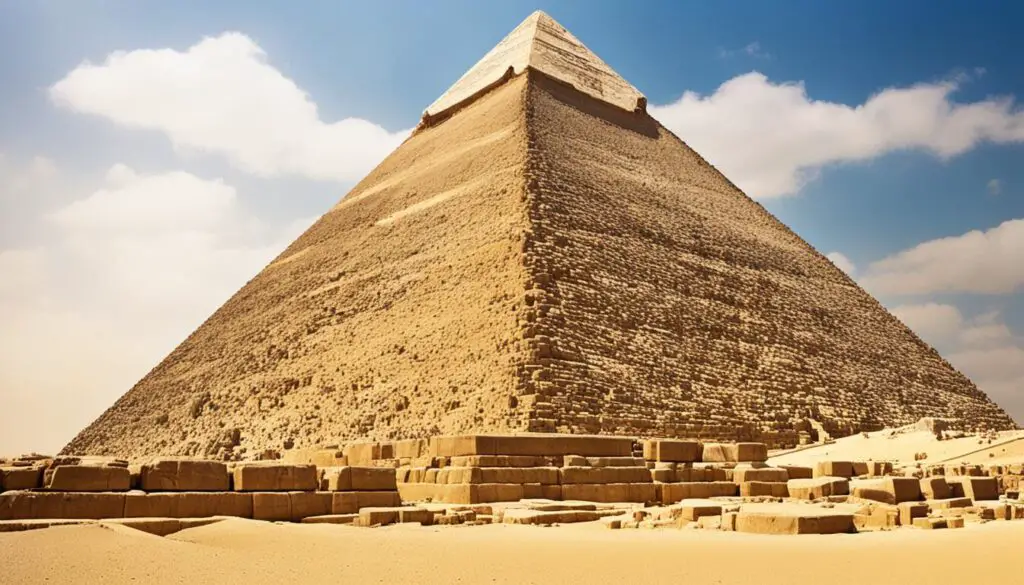Discovering the Ancient Architectural Wonders of the World
The ancient world is filled with remarkable architectural wonders that have stood the test of time. From the Great Pyramids of Egypt to the Colosseum in Rome, these structures continue to awe and inspire people today. Let’s explore some of the most significant ancient architectural wonders from around the globe.
Key Takeaways:
- Ancient architectural wonders are a testament to the creativity and ingenuity of ancient civilizations.
- Worldwide, there are numerous historical sites that showcase remarkable architectural achievements.
- Exploring these ancient wonders allows us to connect with our shared human history.
- Preserving and protecting these structures ensures future generations can appreciate their historical significance.
- Understanding ancient architecture helps us gain a deeper appreciation for the achievements of our ancestors.
The Great Pyramid of Giza: A Testament to Ancient Engineering
The Great Pyramid of Giza, located in ancient Egypt, stands as a remarkable testament to the engineering prowess of the ancient Egyptians. Built as a tomb for the pharaoh Khufu over 4,500 years ago, it is the largest and oldest of the three pyramids at Giza.
This engineering marvel stands tall at approximately 146 meters and is made up of over 2 million limestone blocks, each weighing an average of 2.5 tons. The precision and alignment of these massive blocks demonstrate the advanced knowledge and techniques that ancient Egyptian civilization possessed.

The Great Pyramid of Giza features four perfectly aligned sides that point precisely to the cardinal directions. Its internal passages, including the famous Ascending and Descending Passages, showcase the intricate design and architectural expertise of the ancient Egyptians.
This ancient wonder continues to intrigue researchers and visitors alike, offering glimpses into the rich history and culture of ancient Egypt. Its grandeur and magnitude leave spectators in awe, as it serves as a testament to the achievements of one of the most extraordinary civilizations in human history.
The Colosseum: A Grand Amphitheater in Rome
The Colosseum, also known as the Flavian Amphitheater, is an iconic symbol of ancient Rome. Completed in 80 AD, it was the largest amphitheater ever built at that time, with a seating capacity of up to 50,000 spectators.
The Colosseum was a venue for various events, including gladiatorial games, mock naval battles, and animal hunts. Its elliptical shape and innovative architectural design allowed for efficient crowd control and provided unrestricted views of the activities inside.
“The Colosseum is a stunning testament to the grandeur and sophistication of ancient Roman engineering. It stands as a remarkable achievement of the ancient world.” – Archaeologist Marcus Aurelius
Despite suffering from natural disasters and vandalism over the centuries, the Colosseum remains an impressive testament to the grandeur and sophistication of ancient Roman engineering.
The Great Wall of China: A Monument of Defense and Unity
The Great Wall of China is an astounding ancient architectural wonder that spans over 13,000 miles across the northern region of China. Constructed by various Chinese dynasties over several centuries, this monumental structure served as an imposing defensive barrier against invasions from nomadic tribes.
The strategic design of the Great Wall incorporated watchtowers, beacon towers, and fortresses, facilitating communication and providing a robust line of defense along its entire length. These defensive features allowed the ancient Chinese to protect their territory and maintain unity within their vast empire.

The Great Wall of China’s remarkable historical significance has earned it the prestigious recognition as a UNESCO World Heritage site. It symbolizes not only the remarkable engineering prowess of ancient China but also the rich history, culture, and national unity of the Chinese people.
Conclusion
The ancient architectural wonders discussed above provide just a glimpse into the rich historical and cultural heritage that exists around the world. These awe-inspiring structures continue to captivate our imagination and stand as a testament to the creativity, ingenuity, and perseverance of ancient civilizations.
Understanding and appreciating the historical significance of these ancient architectural wonders allows us to connect with our shared human history and gain a deeper appreciation for the achievements of our ancestors. These structures provide invaluable insights into the architectural and engineering brilliance of the ancient world.
It is crucial that we preserve and protect these cultural heritage sites for future generations to experience and admire. By safeguarding these ancient architectural wonders, we can ensure that they remain a source of inspiration and a tangible link to our past. Let us continue to celebrate and cherish these remarkable structures that have withstood the test of time.








